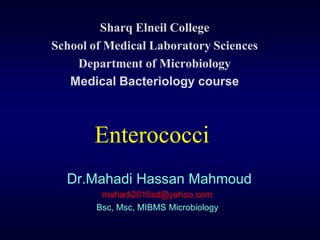Enterococci ppt mahadi
The document discusses Enterococci, including its natural habitats, morphology, general properties, medically important species, culture characteristics, virulence factors, pathogenicity, laboratory diagnosis, biochemical tests, Lancefield grouping, antibiotic resistance, and treatment options. Key points include that Enterococci normally inhabit the intestinal tract, oral cavity, and vaginal canal of humans and animals. The most common medically important species that cause nosocomial infections are Enterococcus faecalis and E. faecium. Laboratory identification involves culture, biochemical tests like catalase and sugar fermentation reactions, and determining Lancefield grouping. Antibiotic resistance is a concern, especially for vancomycin and penicillin.

Recommended
Recommended
More Related Content
What's hot
What's hot (20)
Similar to Enterococci ppt mahadi
Similar to Enterococci ppt mahadi (20)
More from Mahadi Hassan Mahmoud Abdallah
More from Mahadi Hassan Mahmoud Abdallah (20)
Enterococci ppt mahadi
- 1. Sharq Elneil College School of Medical Laboratory Sciences Department of Microbiology Medical Bacteriology course Enterococci Dr.Mahadi Hassan Mahmoud mahadi2010sd@yahoo.com Bsc, Msc, MIBMS Microbiology
- 2. The Natural habitat Normal components of the flora of: Intestinal tract Oral cavity Vaginal canal of humans and animals
- 3. Morphology Gram-positive cocci (0.5 and 1.25 micrometers in diameter) usually occur in pairs or short chains Non-capsulate Non-motile.
- 4. General properties: production of gas from glucose (most enterococci are negative) Have ability to grow at both 45°C and 10°C temperatures). Can grow on media containing Bile aesculin,
- 5. Medically Important species At least 12 different species have been associated with various illnesses Enterococcus faecalis and E. faecium — have emerged as a major cause of nosocomial infections
- 6. Culture &chaacteristics: Enterococci are aerobic organisms capable of growing over a wide temperature range, 10–45 ºC On blood agar, Enterococci are mainly nonhaemolytic but some strains show alpha or beta- haemolysis
- 7. ON MacConkey &CLED Ferments lactose, producing small dark- red magenta colonies on MacConkey aga small yellow colonies on CLED (cysteine lactose electrolyte-deficient) agar
- 8. Enterococcus species are also able to grow in the presence of 6.5% sodium chloride and 40% bile. When grown on media containing aesculin, enterococci hydrolyze the aesculin, producing black colonies.
- 10. Virulence Factor Polysaccharides on the surface of enterococci represent an effective way to prevent phagocytosis. Secreted factors (cytolysin/hemolysin, gelatinase and serine protease) cell surface-located proteins or adhesins (Esp) and the adhesin of collagen Adhesins (Acm and SagA)
- 11. Pathogeicity: Enterococcus faecalis, causing about 95% of enterococcal infections including infections of the Urinary tract infection Biliary tract,ulcers (e.g. bed sores) Wounds (particularly abdominal) Occasionally endocarditis or meningitis
- 12. Laboratory diagnosis specimens: Collection of Spacimen Direct Exam Culture Identificaion Serology Molecular characterization
- 13. Biochemical Tests Catalase negative Ferment lactose (also mannitol and other sugars). Hydrolyze aesculin Reduce litmus milk
- 14. grow on reduce sorbitol glycerol, D- L- melibios 0.4% tetrazol tagatose arabinos e telluride ium to e formaz an E. yes Yes Acid Acid Acid No Acid No Acid faecalis E. No No No Acid No Acid No Acid Acid Acid faecium
- 15. Lancefield Grouping Enterococci possess Lancefield Group D antigen (as also some streptococci). The Group D antigen of enterococci is unlike that of other Lancefield groups. It is not extracted by traditional acid extraction techniques. Enzyme techniquesbased on Maxted’s enzyme are required.
- 16. Antibiotic Resistant Most enterococci are susceptible to ampicillin and resistant to cephalosporins. Resistance is shown against penicillin. Vancomycinand ampicillin resistance appear to be emerging,associated particularly with hospital infections.
- 17. Penicillin or Ampicillin Vancomycin For urine isolates Fluoroquinolones Nitrofurantoin Fosfomycin Vancomycin-resistant strains (VRE)
- 18. THANK YOU FOR ATTENTION